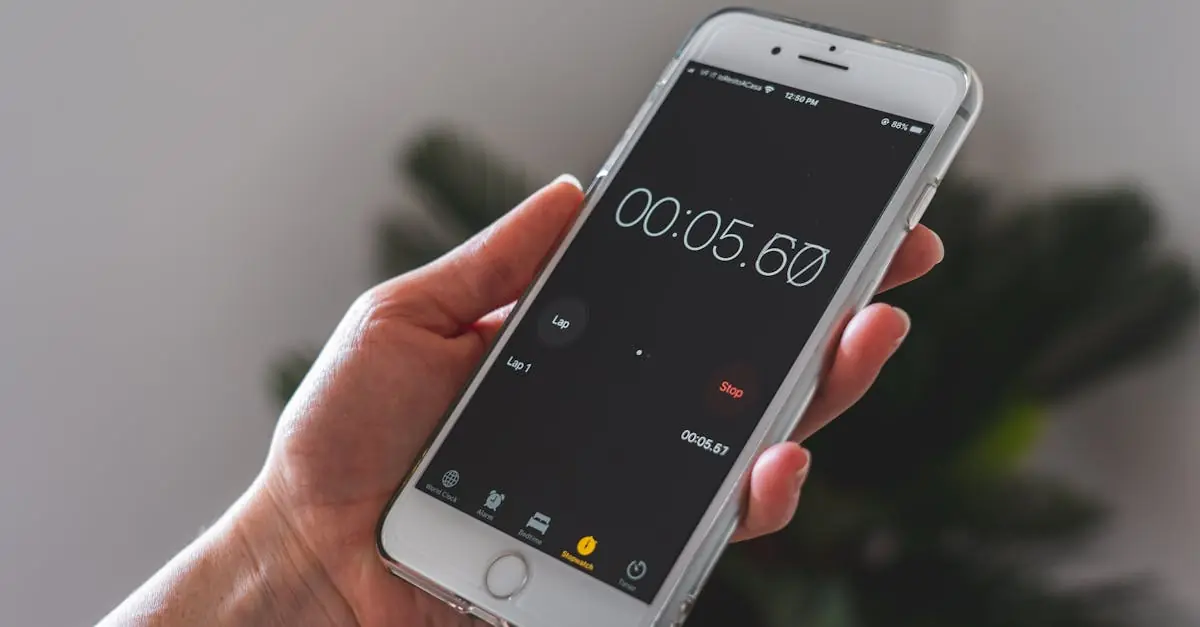Table of Contents
ToggleImagine this: it’s a peaceful morning, and suddenly your iPhone alarm blares like a firetruck on a mission. You groggily reach for it, hoping to silence the chaos. But how long will that relentless beeping continue before it finally gives up? If you’ve ever found yourself in this wake-up battle, you’re not alone.
Understanding iPhone Alarms
iPhones offer reliable alarm features designed for user convenience. Many people depend on these alarms to wake them up or remind them of scheduled events.
How Alarms Work on iPhones
Alarms on iPhones operate through a dedicated Clock app. Users can set multiple alarms with varied times and sounds. Each alarm persists for nine minutes if not dismissed or snoozed. The device repeats the alarm sound until it is silenced manually or the user presses snooze.
Different Alarm Types Available
Several alarm types cater to diverse user needs. Standard alarms sound at set times and can be customized with various tones. Snooze alarms allow a short delay before the next wake-up call. Another option, bedtime alerts, encourage users to maintain a consistent sleep schedule. These features ensure flexibility and coverage for different daily routines.
Duration of iPhone Alarms
iPhone alarms provide users with a reliable wake-up experience. They operate based on specific settings designed for convenience and effectiveness.
Default Alarm Duration
Default settings on iPhones allow alarms to ring for nine minutes if not dismissed. Users experience repetition of the sound until they manually stop it. This mechanism ensures that even heavy sleepers get a chance to wake up comfortably. Many people appreciate this burst of sound, as it offers a few extra moments to adjust to waking up. Some users may find the nine-minute interval sufficient, while others may prefer additional settings.
Customizing Alarm Settings
Users can customize alarm settings to suit their preferences. One option allows for snoozing, which temporarily silences the alarm for a short period, typically around nine minutes. He or she can also set multiple alarms at once, allowing for various wake-up times. Adjusting sound choices provides another layer of personalization, promoting a more enjoyable waking experience. Exploring these features contributes to better alarm management. Overall, customizing alerts ensures alarms are effective and cater to individual needs.
User Experiences and Feedback
Many users share their thoughts about iPhone alarms, often highlighting their reliability. Common concerns center around how long the alarm sounds before stopping, with most users expecting the familiar nine-minute interval to repeat. Users frequently ask if there’s a way to change the duration or sound settings for these alarms. They also express interest in knowing whether silent mode affects alarm functionality.
Users report varied experiences with alarm behavior. Some find alarms surprisingly persistent, often ringing repeatedly until manually silenced. Variability tends to arise from the user’s interactions with the device, such as the choice to snooze or dismiss the alarm. Factors like software updates or user settings can influence this behavior, adding an extra layer of personalization. Ultimately, the effectiveness of these features can hinge on individual use and preferences.
Tips for Managing iPhone Alarms
Managing iPhone alarms effectively enhances the overall user experience. Users can implement several strategies to optimize their alarm settings and ensure reliability.
Ensuring Accurate Alarm Functionality
Checking the alarm settings regularly promotes consistent performance. Ensure the volume is set appropriately to avoid missing alarms. Keeping the device’s software updated is crucial for maintaining optimal functionality. Users should disable Do Not Disturb during alarm times to ensure the notifications come through as expected. Testing alarm sounds periodically can identify any issues before they impact important wake-up calls. Each adjustment contributes to a more seamless experience.
Alternatives to Default Alarms
Exploring alternative alarm options offers users more flexibility. Various third-party apps provide additional features, such as customizable snooze intervals and unique sounds. Choosing a vibrating alarm can complement the sound, increasing the likelihood of waking up. Users also find compatibility with smart home devices useful for creating an integrated waking system. Enabling reminders and calendar notifications can serve as supplementary cues. Selecting these alternatives ensures a tailored approach to morning routines.
Understanding how long an iPhone alarm will ring is essential for effective morning management. With its default nine-minute duration users can rely on this feature to ensure they wake up on time. The ability to customize alarms enhances the waking experience while accommodating individual preferences.
Whether it’s setting multiple alarms or using the snooze feature users can tailor their approach to fit their daily routines. By regularly checking settings and exploring third-party options users can optimize their alarm experience. Ultimately it’s about finding the right balance between reliability and personalization to ensure a smooth start to the day.





